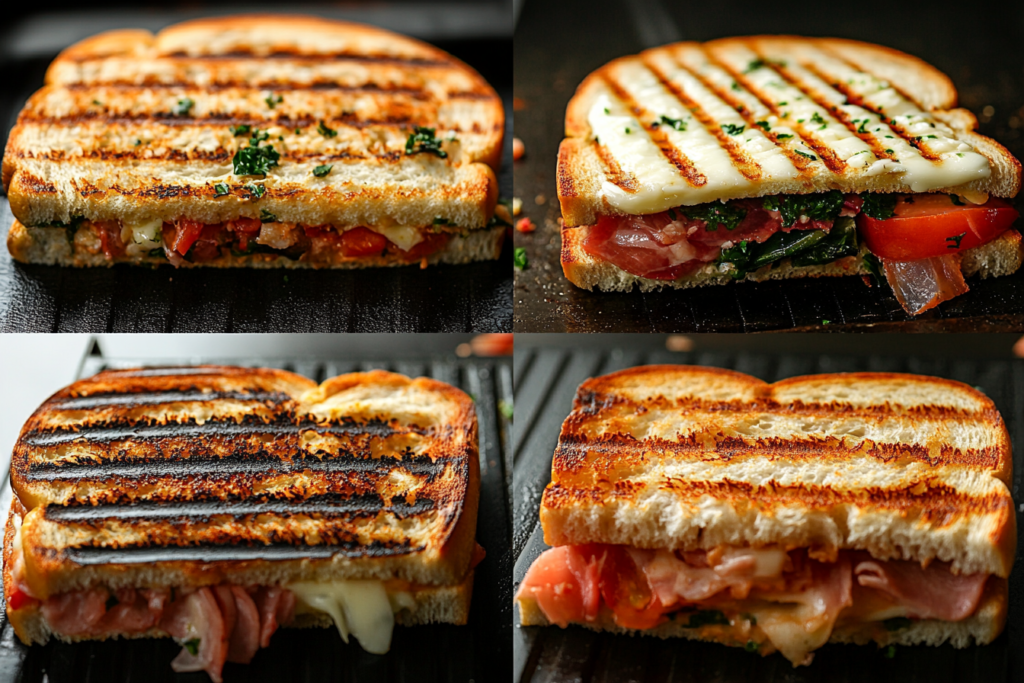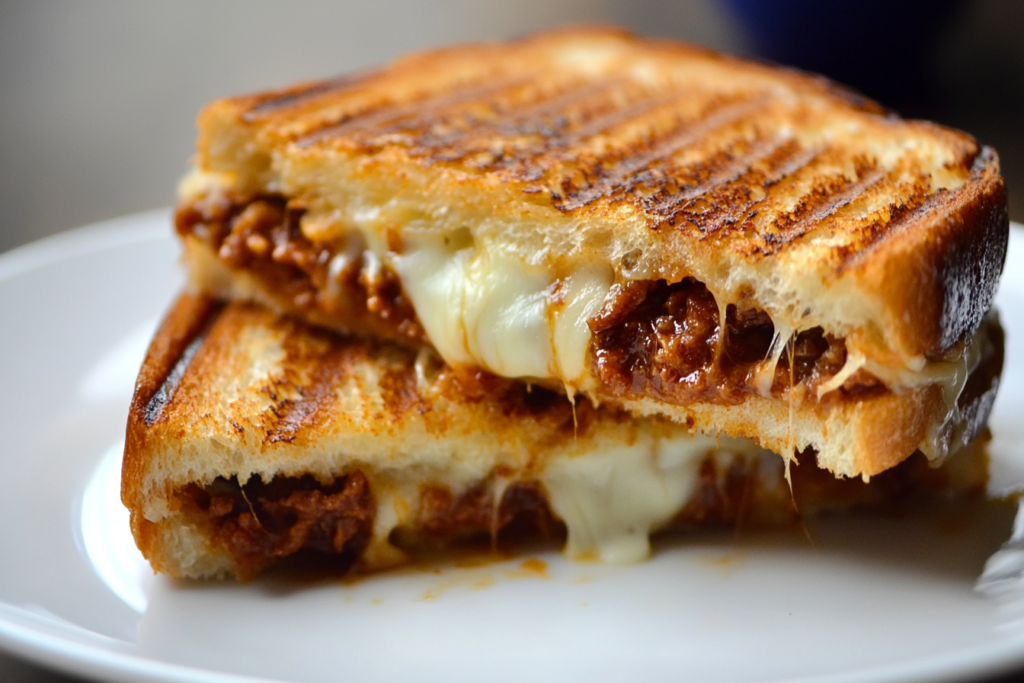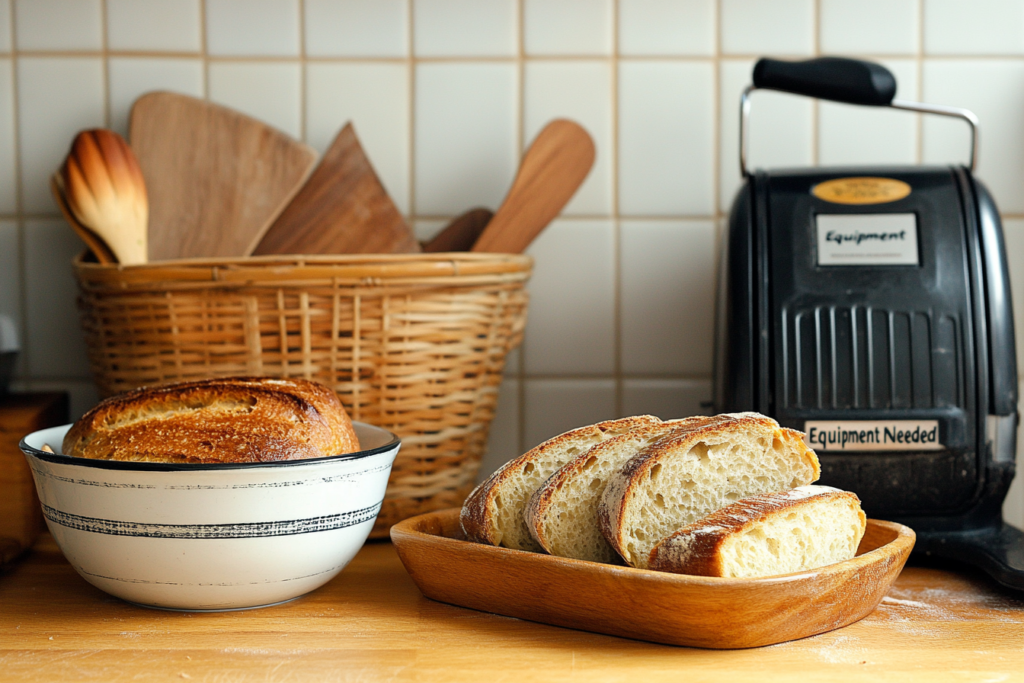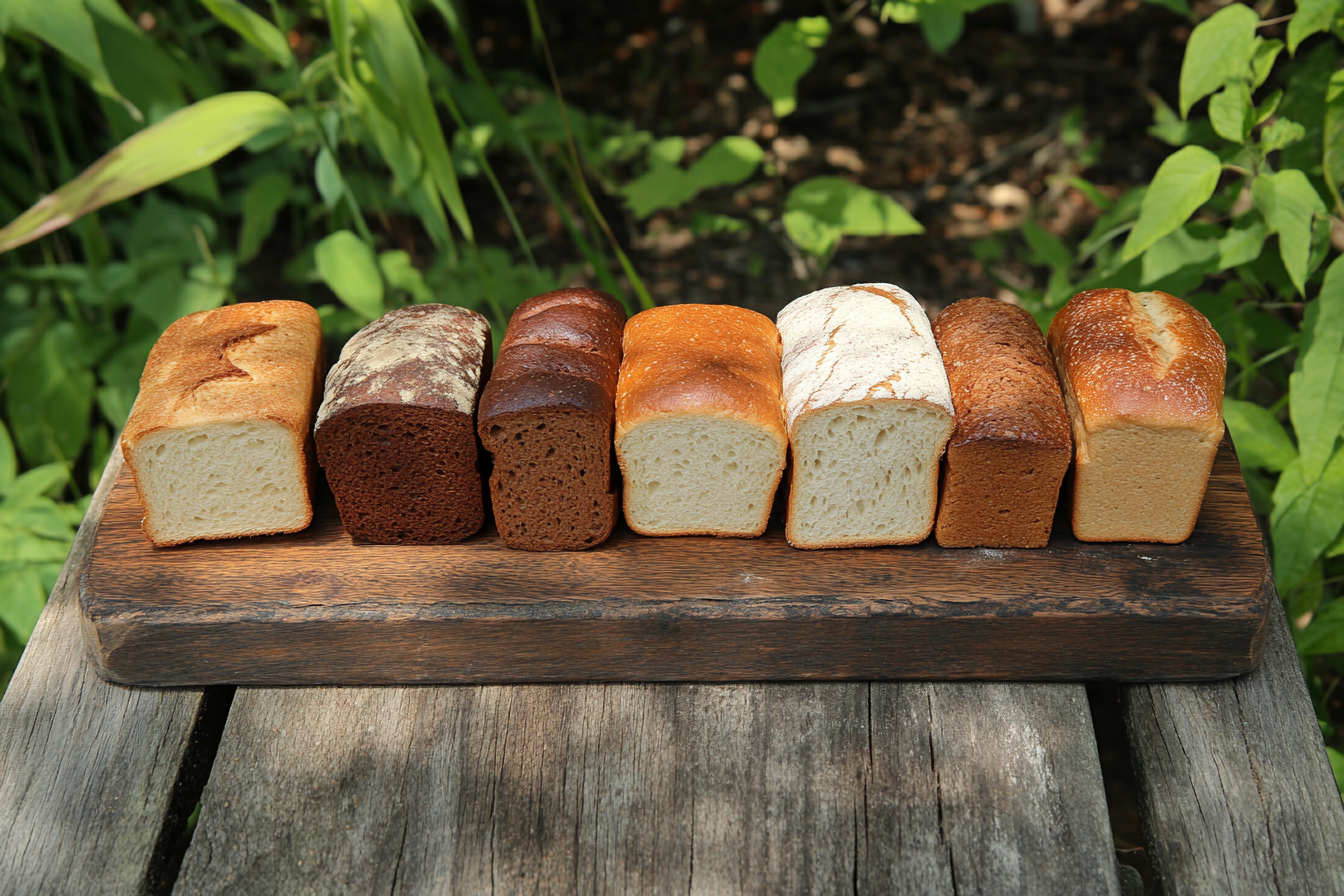Table of Contents
The Difference Between Bread and a Panini: An Overview
When discussing the difference between bread and a panini, it’s essential to understand that while all paninis start with bread, not all bread qualifies as a panini. This distinction lies in the type of bread used, the preparation methods, and the final presentation.
Types of Bread Used in Panini and Regular Bread
Difference Between Bread and a Panini: Bread Varieties
The difference between bread and a panini often begins with the type of bread. Regular bread encompasses a wide variety, including sourdough, whole wheat, rye, and more. In contrast, panini typically use specific types of bread that are ideal for grilling.
Common Breads for Panini
- Ciabatta: A popular choice due to its airy texture and crispy crust.
- Focaccia: Known for its rich flavor and olive oil infusion.
- Baguette: Offers a sturdy structure, perfect for holding fillings.
- Pane Toscano: An Italian bread without salt, allowing fillings to shine.
- Sourdough Panini Bread: Combines the tangy flavor of sourdough with the sturdiness needed for grilling.
Regular Bread Varieties
- Whole Wheat: Made with whole grains, offering a denser texture.
- Sourdough: Characterized by its tangy flavor and chewy crust.
- Rye: Known for its distinct taste and denser crumb.
- Multigrain: Packed with various grains and seeds, providing a hearty texture.
- White Bread: Soft and versatile, commonly used for everyday sandwiches.
Preparation Methods: Crafting a Panini vs. Regular Bread
Difference Between Bread and a Panini: Preparation Techniques
The difference between bread and a panini is not only in the ingredients but also in how they’re prepared. Regular bread is baked and enjoyed as is, while a panini undergoes additional steps to achieve its signature taste and texture.
Preparing Regular Bread
- Mixing Ingredients: Flour, water, yeast, and salt are combined.
- Proofing: The dough rises to develop flavor and texture.
- Baking: The dough is baked until fully cooked.
- Cooling: Bread is allowed to cool before slicing and serving.
Crafting a Panini

- Choosing the Right Bread: Selecting a bread that can withstand grilling.
- Adding Fillings: Meats, cheeses, vegetables, and spreads are layered.
- Assembling the Panini: Ensuring even distribution of fillings for balanced flavor.
- Grilling: Paninis are pressed and grilled, creating a warm, crispy exterior.
- Serving: Paninis are often served hot, immediately after grilling to maintain texture.
Texture and Flavor: How Panini Differ from Regular Bread

Difference Between Bread and a Panini: Texture and Taste
The difference between bread and a panini is evident in their texture and flavor profiles. Regular bread offers a versatile foundation, while paninis provide a more complex taste experience due to the grilling process and added fillings.
Texture Differences
- Regular Bread: Can range from soft to crusty, depending on the type.
- Panini: Features a crispy, toasted exterior with a warm, melty interior.
- Contrast in Moisture: Regular bread can be moist or dry, while paninis maintain a balanced moisture level from the fillings and grilling process.
Flavor Enhancements
- Regular Bread: Primarily showcases the flavor of the grains used.
- Panini: Incorporates diverse flavors from fillings and grilling, such as smoky, savory, and tangy notes.
- Complexity: Paninis often combine multiple flavors and textures, creating a more dynamic taste experience compared to the straightforward flavor of regular bread.
Nutritional Aspects: Comparing Bread and Panini
Difference Between Bread and a Panini: Nutrition
Understanding the difference between bread and a panini also involves examining their nutritional content. While bread provides essential carbohydrates, paninis can offer a more balanced meal with proteins, fats, and vegetables.
Nutritional Breakdown of Regular Bread
- Carbohydrates: Primary energy source.
- Fiber: Especially in whole grain varieties.
- Vitamins and Minerals: B vitamins, iron, and magnesium.
- Calories: Varies by type, with whole grain breads typically being more nutrient-dense.
Nutritional Benefits of Panini
- Protein: From meats, cheeses, or plant-based alternatives.
- Healthy Fats: From cheeses, oils, and spreads.
- Vegetables: Adding vitamins, minerals, and fiber.
- Balanced Meal: Combines carbohydrates from bread with proteins and fats, making it more satiating.
- Customization: Ability to tailor ingredients for dietary preferences or nutritional needs.
Culinary Uses: When to Choose Bread or a Panini
Difference Between Bread and a Panini: Culinary Applications
The difference between bread and a panini extends to their culinary uses. Bread serves as a staple in various meals, while paninis are typically enjoyed as a hearty lunch or snack option.
Uses of Regular Bread
- Sandwiches: The foundation for countless sandwich varieties.
- Toasting: Perfect for breakfast or as a side.
- Croutons: Used in salads and soups.
- Bread Bowls: Hollowed out for serving dips or stews.
- French Toast: A breakfast favorite made by soaking bread in a custard mixture and frying it.
Uses of Panini
- Gourmet Sandwiches: Elevates standard sandwiches with premium ingredients.
- Light Meals: Offers a complete meal with minimal sides.
- Entertaining: Ideal for serving guests with diverse tastes.
- Picnics and On-the-Go Meals: Convenient and easy to eat without utensils.
- Culinary Creativity: Allows for experimentation with various fillings and flavor combinations.
Equipment Needed: Tools for Making Bread vs. Panini

Difference Between Bread and a Panini: Necessary Tools
The difference between bread and a panini also involves the tools required for preparation. While bread baking relies on ovens and basic utensils, making a panini necessitates specialized equipment for grilling.
Tools for Baking Regular Bread
- Oven: Essential for baking.
- Mixing Bowls: For combining ingredients.
- Loaf Pans: For shaping the bread.
- Proofing Baskets: For shaping dough during the rise.
- Bread Knife: For slicing after cooling.
Tools for Crafting Panini
- Panini Press: Key for grilling and pressing the sandwich.
- Cutting Board and Knife: For preparing fillings.
- Spatula: To handle the panini during grilling.
- Butter Knife or Brush: For spreading oils or butter to enhance grilling.
- Parchment Paper: To prevent sticking and ensure even grilling.
Cultural Significance: Bread vs. Panini Around the World
Difference Between Bread and a Panini: Cultural Context
Exploring the difference between bread and a panini also involves understanding their cultural significance. Bread is a global staple with countless variations, while paninis have their roots in Italian cuisine but have gained worldwide popularity.
Bread in Various Cultures
- France: Baguettes are a daily staple.
- India: Naan bread accompanies many dishes.
- Mexico: Tortillas are fundamental to the cuisine.
- Middle East: Pita bread is widely used in various dishes.
- Ethiopia: Injera serves as both a plate and utensil for meals.
Panini’s Italian Heritage
- Origins: Originated in Italy as a pressed sandwich.
- Global Adaptation: Adapted worldwide with local ingredients.
- Culinary Fusion: Combines traditional Italian flavors with modern tastes.
- Social Aspect: In Italy, paninis are often enjoyed at cafes and as street food.
The Evolution of Panini in Modern Cuisine
Difference Between Bread and a Panini: Modern Trends
The difference between bread and a panini has evolved with modern culinary trends. Paninis have transcended their traditional roots to incorporate global flavors and innovative techniques.
Fusion Paninis
- International Flavors: Incorporating ingredients like kimchi, teriyaki chicken, or Mediterranean spreads.
- Vegan and Vegetarian Options: Utilizing plant-based proteins and dairy-free cheeses.
- Health-Conscious Fillings: Including ingredients like avocado, quinoa, and leafy greens.
Artisanal Paninis
- Gourmet Ingredients: Using high-quality meats, artisan cheeses, and specialty breads.
- Creative Combinations: Experimenting with sweet and savory pairings, such as fig jam with prosciutto.
- Presentation: Emphasizing aesthetic appeal with layered ingredients and vibrant colors.
Technological Advancements
- Advanced Panini Presses: Featuring adjustable heat settings, non-stick surfaces, and multi-functionality.
- Smart Kitchen Appliances: Integrating technology for precise grilling and consistent results.
- Sustainable Practices: Using eco-friendly materials and energy-efficient appliances.
The Role of Panini in Dietary Preferences
Difference Between Bread and a Panini: Dietary Considerations
The difference between bread and a panini also touches on how paninis can cater to various dietary preferences and restrictions, making them a versatile meal option.
Gluten-Free Options
- Gluten-Free Breads: Utilizing alternative flours like rice, almond, or chickpea to create suitable bread for paninis.
- Cross-Contamination Prevention: Ensuring preparation areas and tools are free from gluten to accommodate those with celiac disease or gluten sensitivities.
Low-Carb and Keto-Friendly Paninis
- Alternative Breads: Using low-carb or keto-friendly bread alternatives, such as lettuce wraps or cloud bread.
- Filling Choices: Emphasizing high-protein and healthy fat fillings while minimizing carbohydrate content.
Vegan and Plant-Based Paninis
- Plant-Based Proteins: Incorporating ingredients like tofu, tempeh, or plant-based deli slices.
- Dairy Alternatives: Using vegan cheeses and spreads to accommodate vegan diets.
- Flavor Enhancements: Utilizing herbs, spices, and condiments to create robust flavors without animal products.
High-Protein Paninis
- Protein-Rich Fillings: Adding lean meats, cheeses, and legumes to boost protein content.
- Balanced Nutrition: Combining proteins with carbohydrates and healthy fats for a well-rounded meal.
The Economics of Bread and Panini
Difference Between Bread and a Panini: Cost Considerations
Understanding the difference between bread and a panini also involves examining the economic aspects of preparing and purchasing these food items.
Cost of Regular Bread
- Affordability: Regular bread is often inexpensive and widely accessible.
- Bulk Purchasing: Buying in larger quantities can reduce cost per unit.
- Variety and Price Range: Availability of various types at different price points to suit different budgets.
Cost of Panini
- Ingredient Costs: Paninis can be more expensive due to the inclusion of multiple fillings and higher-quality ingredients.
- Preparation Time: Requires additional time and tools, which can add to the overall cost.
- Dining Out vs. Homemade: Eating paninis at cafes or restaurants can be pricier compared to making them at home.
Value Proposition
- Regular Bread: Offers versatility and a foundation for various meals at a low cost.
- Panini: Provides a complete meal option with diverse flavors and textures, justifying the higher price point for convenience and taste.
Environmental Impact: Bread vs. Panini Production
Difference Between Bread and a Panini: Sustainability
The difference between bread and a panini also extends to their environmental impact, considering factors like ingredient sourcing, preparation methods, and packaging.
Bread Production
- Resource Consumption: Involves significant use of water, energy, and agricultural resources for grain production.
- Carbon Footprint: Varies based on the type of bread and production methods.
- Packaging Waste: Often comes in plastic or paper packaging, contributing to waste.
Panini Production
- Ingredient Diversity: Incorporates various ingredients, each with its own environmental footprint.
- Energy Use: Requires energy for grilling and pressing, especially when using electric appliances.
- Waste Management: Additional packaging and waste from fillings can increase overall environmental impact.
Sustainable Practices
- Local Sourcing: Choosing locally produced bread and fillings to reduce transportation emissions.
- Eco-Friendly Packaging: Utilizing recyclable or compostable packaging materials.
- Energy Efficiency: Using energy-efficient appliances for grilling paninis to minimize energy consumption.
The Future of Panini in Culinary Trends
Difference Between Bread and a Panini: Emerging Trends
As culinary trends evolve, the difference between bread and a panini continues to adapt, embracing innovation and changing consumer preferences.
Health-Conscious Innovations
- Nutrient-Enriched Breads: Incorporating superfoods like chia seeds, flaxseeds, and quinoa into panini bread for added health benefits.
- Low-Sugar and Whole Grain Options: Catering to consumers seeking healthier alternatives without compromising on taste.
Technological Integration
- Smart Kitchen Appliances: Utilizing panini presses with smart technology for precise temperature control and optimal grilling.
- Automation: Exploring automated systems for consistent panini preparation in commercial settings.
Global Influences
- International Flavors: Introducing flavors and ingredients from different cuisines to create unique panini experiences.
- Cultural Fusion: Blending traditional Italian panini with other cultural elements to appeal to a diverse audience.
Sustainability Focus
- Eco-Friendly Ingredients: Prioritizing organic, non-GMO, and sustainably sourced ingredients for panini fillings and bread.
- Waste Reduction: Implementing strategies to minimize food waste during panini preparation and serving.
Conclusion
The difference between bread and a panini is multifaceted, encompassing variations in bread types, preparation methods, texture, flavor, nutritional content, and cultural significance. While bread serves as a versatile staple across the globe, paninis offer a specialized, flavorful, and satisfying meal option that has evolved with modern culinary trends. Understanding these differences allows for better appreciation and utilization of both in diverse culinary contexts.
Frequently Asked Questions
What is the difference between panini bread and regular bread?
Panini bread is typically sturdier and has a denser texture compared to regular bread, allowing it to hold fillings without becoming soggy. It’s often designed to crisp up when grilled, enhancing the panini experience.
What makes it a panini?
A panini is defined not just by the bread but also by the preparation method. It involves grilling or pressing the sandwich, which creates a warm, crispy exterior and melts the fillings, distinguishing it from regular sandwiches.
Is a panini just a baguette?
While a baguette can be used to make a panini, not all baguettes qualify as panini. Panini are characterized by the specific preparation method and the combination of fillings, making them more than just a type of bread.
How is panini different?
Panini differ from regular sandwiches through their grilling process, which enhances flavor and texture. The use of pressed bread and the variety of fillings also set paninis apart, offering a unique and satisfying meal option.

